
Saturday 26th September Fast road to Agadir 156 miles
We enjoyed our 'haven' in the wilderness. After we'd finished breakfast, a smiling moslem lady brought us two warm rolls, as it had said on the leaflet. They were good at lunchtime.
We finished working on the website and sent the second email.
We had decided not to travel over the Tiz n Test pass, having read that it was extremely narrow and winding, so we now had to rethink our route once again.
We sat outside where there were blackbirds, sparrows, a dove and a magpie and finally left at 11.15.
We drove the 2.5 km bumpy and convoluted track back to the tarmac and then had to drive around Marrakech. We needed more diesel so pulled into a Shell garage, but they didn't take Visa, and directed us to an Affriqua petrol station, which hadn't taken visa before. This time they did, but said it would be 5 minutes while a tanker refilled the pumps. The 5 minutes was more like 15! There were dozens of mopeds lining up, waiting to get petrol. We were then aware of them as we drove through all the crazy traffic as we rounded Marrakech. We had to drive through several narrow archways in the walls. At one, where there was a 'no entry' sign, the police just watched but didn't help!
We ate the pizza, sitting out under the almost full moon and coming in reluctantly at 9.30.
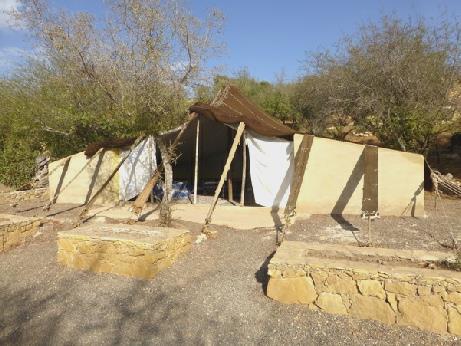
You could stay in a Berber tent in many of the campsites
The beautiful pool Refreshed after a swim
Sunday 27th September Into the Anti Atlas 97 miles
The scenery was now splendid, with bare, steep rocky mountainsides. These had once been terraced, but now had just a scattering of prickly pears and a few trees. When we stopped for lunch in this glorious wilderness, Adrian discovered that we were not on the right road!
Some of the hundreds of goats in the valley
The road we were on didn't exist on any map we had, but ran parallel to the one we should have been on. Luckily it joined up in a few more kilometres, as we then came to several bridges which had had trouble in previous rains, and now we had a few drops ourselves!
As we joined the 'right' road, we were surrounded by massive bare rocky mountains. Soon afterwards we passed the impressive site of the fortified village of Tioulit, set on top of a conical hill.

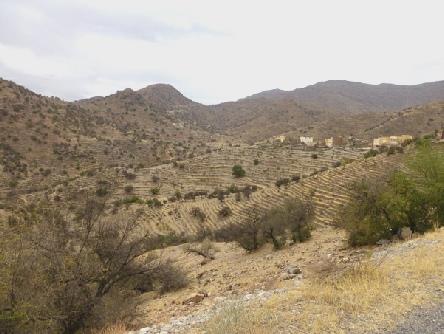
Former terraces before we stop for lunch
The road now to Tafraout, where we proposed staying tonight, had just a narrow strip of tarmac. Adrian became frustrated at always having to pull off onto the gravel when we met an oncoming car, and started standing his ground. This was nerve racking for me, sitting on the off side!

The dramatic fortified village of Tioulit
At 3.30 we arrived at le Trois Palmiers campsite, just outside the city walls. There was an area with walls around, but also you could park in the 'desert' outside, amongst the palms. We opted for this, and after settling in, had a lovely walk around amongst the palm trees, surrounded by bare granite mountains - it made us think of being in Australia. We saw a bird, which we thought from our book was a house bunting, not found in Britain. There were animal droppings on the ground, looking like rabbit pellets. Although still warm, it was cool enough to enjoy walking.

Wonderfully remote scenery as we descend to Tafraout
For the first time for a long time, we ate supper inside.
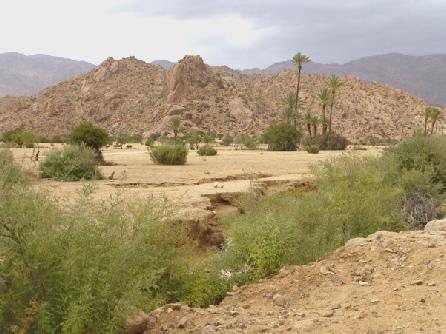

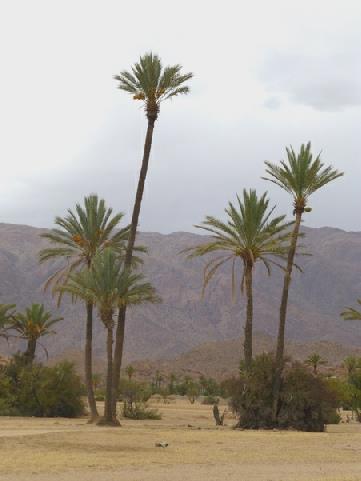

Glorious walk at Tafraout where we saw a house bunting
Monday 28th September To the Atlantic coast for our 600th night in the Ixi 141 miles
A day of mixed weather, and not without its associated problems!
We awoke to rain!! Something we weren't used to!
Nobody had come to collect any money, so by 8.50 we were on our way - driving back first into the town of Tafraout. At least the rain showed up the potholes! We had read that most of the men of this town work abroad, sending home cash to their families, so we were surprised to see a lot of men as we drove around. Some made us smile, as they wore gaberdine looking gowns over their usual ones! We noticed that Moroccan people look just as despondent as English in wet weather! It had now stopped raining, but like last night, we saw nothing in the town to stop for, so drove on through the stunning red granite scenery. The tarmac was very narrow at first, but at least the road wasn't busy then. The tarmac did widen, which made the driving easier.

There was an amazing vertical rock strata, with palms in the valley bottom.
A better bit of road - but only one car wide!
Always trouble at the bridges where the abutments get washed away

Remote red scenery
The road which Adrian had been unsure about turned out to be reasonably straight and fairly level even if it was at 1300m most of the way. In fact the 1000m we dropped to Guelmim was hardly noticeable.
We drove through the very Moroccan town of Ifrane d'Anti Atlas, then when we stopped for lunch it was sunny and warm. We reached the R102 and when we got to Bouizakarne we joined the N1 to Guelmim. It was a straight, monotonous drive, and the skies looked threatening. And then the rain came - violently and frighteningly. Visibility was really low, but there was nowhere we could pull off. Then all hell let loose! The rain didn't last long, but very quickly everything had become flooded. Pedestrians were wading across 'red lakes' of roads, and cars were splashing past.
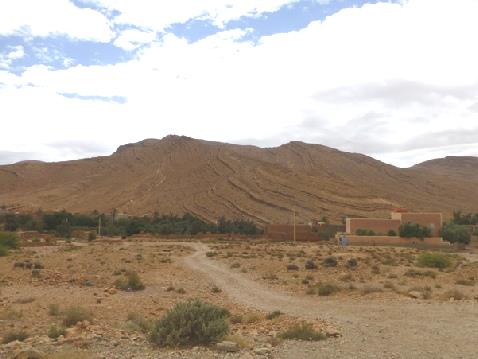
We contemplated what to do. We had passed any possible places to stay, but wondered about going further. It was an anxious time! We had been worried about flood damage on the minor mountain roads, and here we were in a large town and now we had problems. We drove through one flood after another, water swishing in rivers across the road and making new channels. We now couldn't turn round, as floods could become deeper, so we just kept going! Eventually we came to slightly higher ground, and felt safer, but still when we came to a bridge we never knew whether it would be go-able.
The road from here to Sid Ifni, on the coast, was through a pretty river valley, but we didn't really appreciate it! We drove the 30 miles, now out of the rain, but with black skies still all around.
We reached Sid Ifni, where there were 3 campsites to choose from. We came right to the coast - by now it was hot and sunny. One site, La Barca, was right by the beach. It featured on the cover of our camping book - packed out with motorhomes. We looked in - there was one tent! Having had a walk onto the vast, almost empty, sandy beach, with the Atlantic rollers crashing on the shore, we entered the campsite and parked looking straight out to sea.

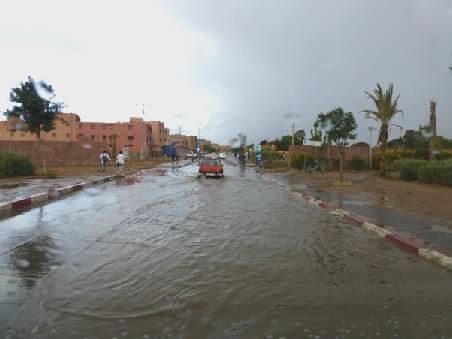
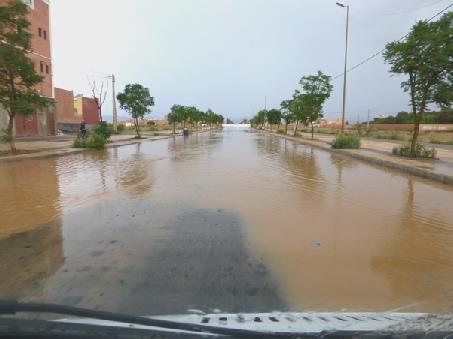

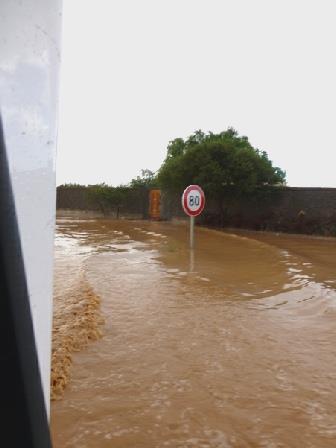
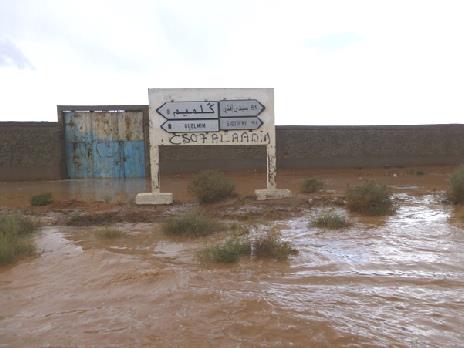

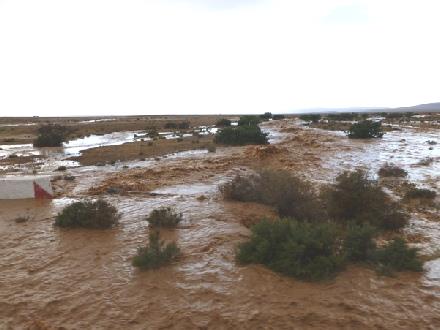
The flash floods start at Guelmim
And then get scarily bad
This is what we'd envisaged, but not dared hope for, for our 600th night in the Ixi!

We reach the tranquility of Sidi Ifni
We celebrated with a bottle of bubbly, watching the sun go down over the sea.

I made a simple meal of cous cous, salmon & sweetcorn – it wasn't the season for the restaurant to be open!
Later we walked across the beach under the full moon – it was still warm.
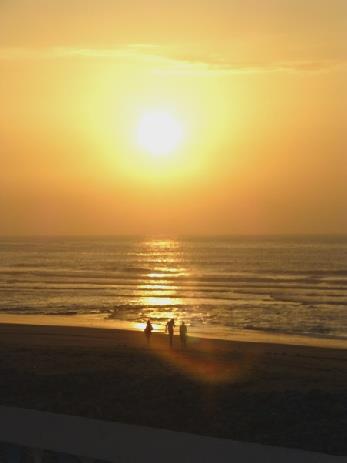
Thursday 29th September A day at Sidi Ifni
We were spending a second day here, and in keeping with 'second days', woke to a cloudy morning! This didn't last though, and by late morning it was sunny and hot. Adrian took our washing over to the lady, who spoke no English (or French) so he didn't know when it would be done – 2 hours or 2 days! She must have meant 2 hours, because later in the morning Adrian collected it and I hung it out – a knicker line by the sea! When we came back from our walk up into the town, it was practically dry.
We'd been surprised to look at the back of the site and see an ostrich! It was in a long enclosure, and was very cheeky when we visited it!
We had read that this was an Art Deco town, painted in blue and white (being built mostly in the 1930's). It was much in need of a repaint! It still had what is known as Plaza de Espana - a square with shady trees looking as if it had come straight from Spain.

A nicely painted part of Sidi Ifni


Plaza de Espana and the Hotel de ville
I had caught up with outstanding emails, so we got off later than we had wanted to walk up the many steps behind the campsite into the town. Sidi Ifni has a strange history - it was ceded to the Spanish after the Moroccan war in 1859, but the Spanish didn't 'move in' until the 1930's. Then they didn't want to leave - even after the French gave Morocco independence. In 1969 Morocco blockaded the town and it was finally handed back.
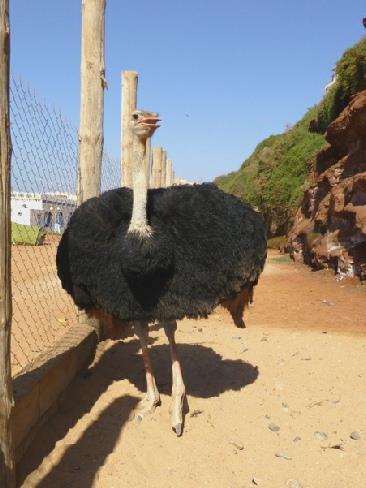
Our surprise companion
Later we had a long walk along the beach past the lagoon where the river comes out, which made beautiful reflections.
The cover of our camping book - and us in our isolation
The sea is quite rough here, but there were just a few people in the water. We paddled a bit on our way back - the water felt warm. We continued along the beach, coming up to the end of the nicely made promenade which runs in front of us, but just ends.
When we came back more campervans had come into the site. A man called down from an upstairs apartment and welcomed us, saying that he had a brother in London, married to a Yorkshire woman. Adrian spoke to a Dutch man who said that they were going to drive south on the N1 from Tiznit to Bouizakarne, but they couldn't because the road was too bad, Adrian also discovered from the internet that last November the area from Guelmim to Sidi Ifni suffered devastating floods in which virtually all the bridges in the area were washed away along with long lengths of road and 36 people lost there lives. We were really lucky yesterday!
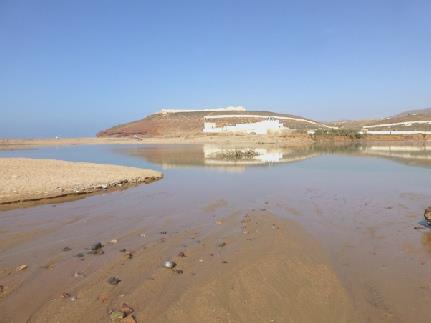
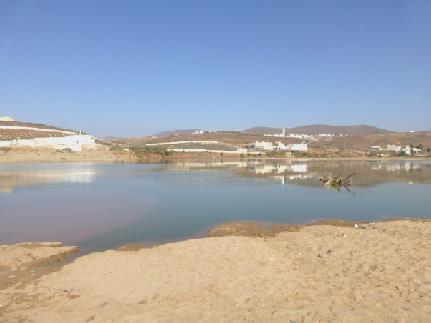
Lovely reflections in the lagoon
Wednesday 30th September Beautiful beaches 55 miles
It was partly cloudy at first, but pleasant outside, and clear by the time we left at 9.30.
We drove north from Sidi Ifni, straight into wild, empty, moorland country.
A few miles on, we turned down to Legzira, a new 'development', hoping to get to the beach, which was supposed to be good, but the unmade red sandy track wasn't for us!
A bit further on, just before Mirhleft, we came to the most beautiful sandy cove hemmed in by red rock cliffs on either side. We walked down onto the beach, taking our coffee with us. We sat on the rocks, surrounded by rock pools with mussels covering the rocks. It seemed like an English or a Welsh beach. We paddled in the pools and at the edge of the sea, coming to a large rock stack on the beach with an arch through it. A beautiful red and blue image.
Driving on into the town, and in urgent need of bread, we stopped by a 'general store', but they only sold household goods. The man directed us to another large 'garage door', and in this one, crammed with mostly tinned goods, we spied bread. We had to wait while two ladies took ages to buy a few sheets of plastic wrapping, then we were served by a pleasant French speaking man and bought 2 hot Moroccan round loaves.
We drove on through the low-key blue and white town of Mirhleft then Adrian spied a newly surfaced road down to a beach, with a car park at the end. And so we came to our second beautiful beach! This one was busier, but again was enclosed by red rocks. After eating lunch, including the hot bread, we walked down across the wide sands and paddled in the waves, feeling not bold enough to swim. A nice young man had asked if we wanted beach chairs, of which there were a few. He seemed to be the car park man too, but wasn't around when it was time for us to leave (unusual!). We were delighted when we got back to the van to see a group of ground squirrels scurrying around on the rocks in front of us. They were scraggier than those we'd seen in USA.

Rock arch on a lovely beach
We left at 2 o'clock, taking the road near the sea, which our book had raved about, but which we found rather drab. Maybe it's different in Spring. We were close to, but never by the sea, driving through beige coloured hills with low tufts of green vegetation.
We reached Aglou Plage, the beach for Tiznit, which is about 15 km inland. It was a 'developing resort', and although there was a campsite here, it wasn't for us.
Instead we headed for Tiznit, where there was a site beside the town walls. Hearing a rattle, I got up to investigate. Suddenly there was a loud bang, and we saw that a bundle had fallen from the top bed. On investigating, we found that it was a bag of clothing, with the box of rocks we had bought wrapped inside. As we feared, the glass lid of the box had smashed into many pieces, so the first thing we did when we arrived at the campsite was to clear it all up!
There were several other vans at this large site (mostly French) but a German man from Hamburg spoke to me, and unusually he didn't seem to speak English, so I was able to use my German.
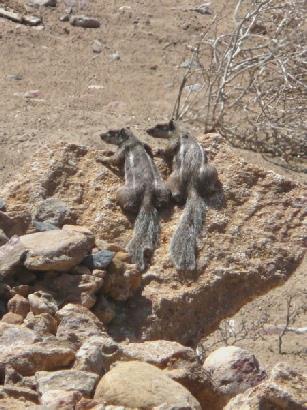
Scraggy ground squirrels
Thursday 1st October To another lovely beach 36 miles
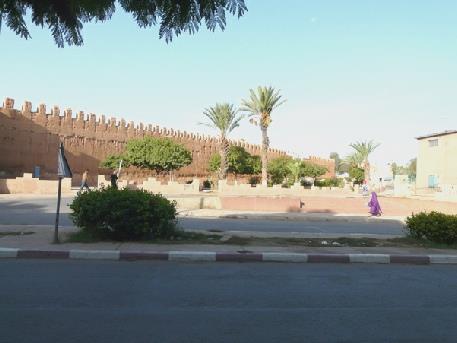
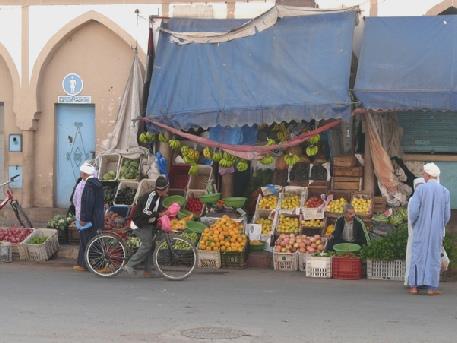
Tiznit
The sun went into cloud, so there was no sunset over the sea again.
The beach at Sidi Wassay
Friday 2nd October All goes well in Agadir 57 miles
We enjoyed looking out to sea from our vantage position to have breakfast. Adrian did the 'emptying', then paid for the campsite. The man had included electricity. Adrian said that we hadn't used it. The man said, yes, I saw the lead out. Adrian explained about the shock, but the man had no change again, so we ended up paying half the electric fee anyway!
We made the long trek back across the fertile Massa River valley. I saw a heron and an egret as we crossed the river. We also passed a lot of loaded donkeys, and some with carts.
We'd wanted to visit the Massa lagoon, as it is apparently a good place to see birds, but sadly the unsurfaced road wasn't for our camper.
We followed the N1 north for some way, turning off to drive, as we thought, through the Massa and Souss National Park. After the urbanisation came to an end, we just crossed miles of desolation!
It was worth it though, as we finally arrived right above the sea, looking to the pretty white village of Tifnit (not to be confused with Tiznit! In fact, the signpost on the N1 pointed to 'Tiznit' one way and 'Tifnit' the other!) Tifnit was set on a promontory, with dozens of blue fishing boats on the shore. It made a nice elevenses stop, apart from the litter.
We looked down to see 4 young girls enjoying the water. A moslem lady stripped off some of her clothes and swam for a long time in the shallow pool made by a large rock, while her husband looked on.
On our return to the N1, we were aware of lots of plastic/net greenhouses. We continued towards Agadir. We were needing to shop again. Adrian had seen that there was a Carrefour in Agadir, but didn't know if we would be able to park the camper there. Hence we stopped once more at Marjanes, although not the one Adrian had been heading for. After shopping, we ate our lunch in the camper. An attendant came and spoke to us – perhaps he thought that we wanted to stay there! We left at 1.30 – it was now hot.
We drove on into Agadir, which was quieter and smarter than we'd anticipated. We headed for Camping International, although our camping book was very disparaging about the site. It was certainly rather scruffy and unlooked after, but was fine for us, and very central to Agadir. There were trees and shrubs and birdsong. So at 2 o'clock we got settled in, with the intention of seeing something of the town - although there's actually very little of interest to see! Agadir suffered a devastating earthquake in 1960; 15,000 people were killed and most of the town was destroyed, so it all dates from that time.
Adrian went to register, and was asked to pay (usually we pay on leaving). The man – in a dreadfully rubbishy place with all the windows broken and patched up) had no change, so kept Adrian's 200dh note, saying to collect the change later!
We walked out, seeing the 'petit train' passing the bottom of the road. We walked along for quite a way to the 'Valley of the birds'. When we reached it, we could see it down below, but didn't know how to get there. As we walked above it, a man came and chatted – of course he had a shop! He said that the park was closed until 4 o'clock. On finding the entrance, we saw that it was open all day! The man reappeared, and said 'open today'!
We walked into a lovely shady chine, which housed aviaries with all sorts of birds – flamingos took our fancy, and there was a large cage of cockatiels like dear Wurdels. Also there was an enclosure of mountain goats. All this, with a waterfall and cooling trees and shrubs, was free. A lovely asset for Agadir!
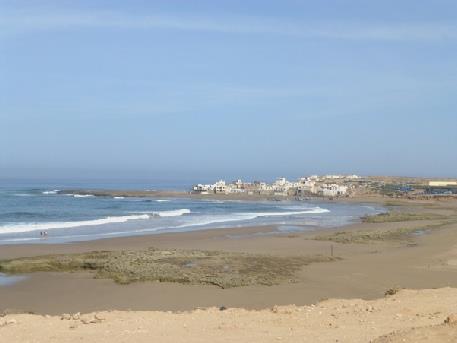

Tifnit - a picturesque coffee stop
As we walked out of the bottom entrance, the petit train was just about to leave. We'd hoped to ride on this, as it would save on walking, when there wasn't much to see anyway. And so for 18dh each (£1.30), we became 'tourists' for half an hour! We didn't know when or if, we'd last been on a petit train!
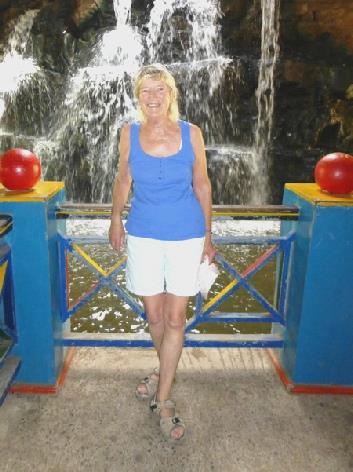
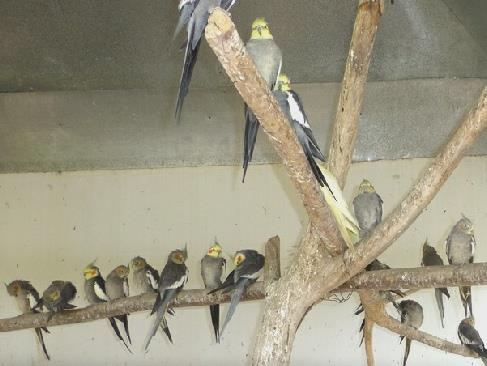
Valley of the birds, Agadir
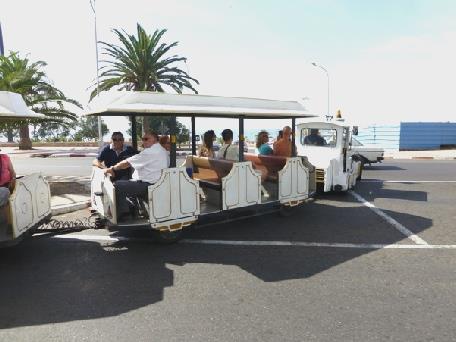
The petit train, Agadir
Saturday 3rd October A swim in the sea at last 64 miles
It was pleasant sitting outside for breakfast, While Adrian was filling up with water, a man asked him if he wanted to buy some fish. He bought a large sole, which the man expertly gutted for him, throwing the bits straight to the many cats, who all crowded round.

We thought that we'd have coffee sitting in the little park by the van, but we hadn't reckoned on the automatic watering coming on! We still sat on the one seat, being 'cooled' by the spray!
We now drove north, past the massive port, and into the hills at the end of the High Atlas. We came to the town of Aourir, in a stunning situation at the bottom of the hills by the sea.
A road goes inland from here to what is known as Paradise Valley. We drove through the bustling Saturday morning town and started up through the yellow scenery, but decided after a while that it was too far to go and then return, so drove back through the town and continued up the coast. There was an awful lot of development on this idyllic coast. We stopped above a huge sandy beach to have lunch, looking down to the Lowry figures on the beach below. There were camels and horses too. The N1 behind us was busy, and noisy when vehicles went over the unmarked tope right by us.
After that we passed one lovely beach after another – some large and sandy, others little rocky coves. We stopped at another large beach where there weren't many people, so the camels and horses had few takers. There were two pedalo 'cars' with slides on them. We saw a group of young men go off into the sea in one – it looked fun.

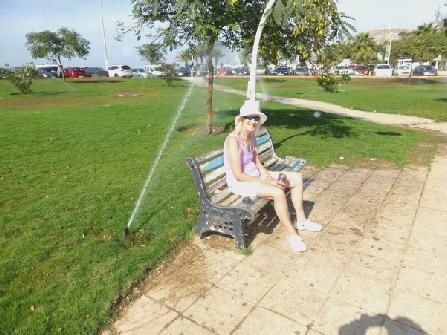
Agadir beach The cooling spray!
We'd taken our Danish seats to sit on, which worked well. The sea here looked calm, although this is really a surfers area. This was the place to entice us both in for a swim, and it was lovely. There were some strange fish swimming with their mouths at the surface of the water.
It was 2.45 when we left here to continue north, passing many more beautiful beaches, mostly empty. We drove around Cap Rhir which was barren, with yellow/white sandy soil. As we drove on an inland loop to Tamri, we saw lots of camels roaming free. The verdant valley here was filled with banana palms.
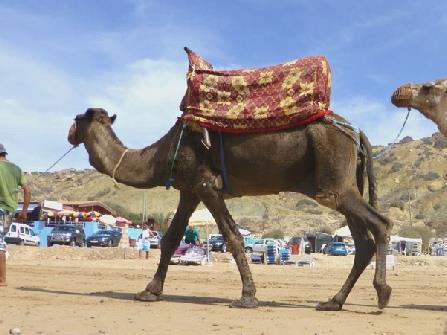
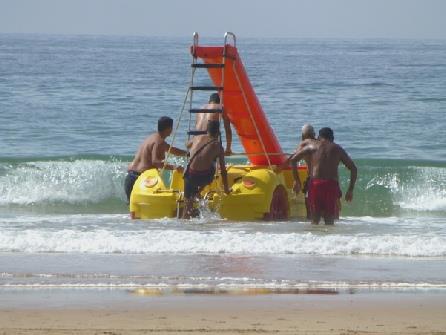
Fun things on the beach
The town itself looked very Moroccan, with the street lined with stalls. When we stopped to take a photo later, we were pestered by a group of young boys.
We saw more camels as we drove through the remote country near the sea. The land was really arid – a beige landscape speckled with green.
We turned off to drive the 8 km to Imsonane, the last 400m being very rough. We then came to our 'quirky' campsite above the sea. Not a soul around! We wandered about - in front of the site were a few shacks and cabins made from rowing boats.

Banana palm filled valley, Tamri
We settled into a position with a view down to the sea, still looking misty, and to the sienna coloured village. We put out the awning for some shade, and were sitting there when along came Colt. He, it turned out, was in charge of the site, while the English owner, whose ugly house looked down from the hill above, returned to England. And so that was the next hour or two gone, while we chatted to Colt, all later drinking one of our beers each. Colt had been born in Arkansas, but for some time had been travelling and working here and there in various parts of the world. We were joined by a little cat 'Straggler', who they had rescued from near starvation and a large dog 'Lewis'. Conversation was easy, as we had many stories to share, but we did decline Colt's offer of hash!
We then came in to cook supper!

Rowing boat cabins at our site at Imsonane
Sunday 4th October Slowly northwards 58 miles
The first thing I had to do was to catch up with yesterday's diary!
It was already hot when we sat out for breakfast. We left at 10 o'clock, waving goodbye to Colt. We drove down to look at the beach, where a few surfers were out. Then it was the trail back through the empty hills to the N1.
We started off northwards and soon saw some goats in a tree, which we wanted to photograph. We turned round, but after passing them, couldn't then turn round again, so had to drive miles back! We returned north once more, and when we did pull in, we were beeped at by a passing car (and they stop all over the place!) After that, we passed several more lots of goats up trees! (They climb the trees to eat the argan nuts)
We came to the town of Tamaner, extra busy as it was market day. I spied a stall selling bread, but we couldn't stop. A bit further on, I saw a barrow of loaves across the road. We pulled in, and Adrian went to get some, but the man set off down the road, so he had to chase him! He returned with two small, hot Moroccan loaves - 1 dh (7p) each!

Goats up a tree
We were driving through an area of yellow orange rocky soil, with lots of argan trees , and there were ‘stalls’ of all sorts selling bottles of argan oil (a bit like olive oil, but more expensive because of its more difficult production).
We had passed several GB motorhomes, coming in the other direction and presumed that they were on a tour, although they were travelling independently.
A lot of people with loaded donkeys passed us, and trucks with animals on top.
Then we came to the town of Smimou with lots more donkeys - and another busy market.
We turned off on a road to the sea just afterwards, passing lots of goats, donkeys and camels in the undergrowth.
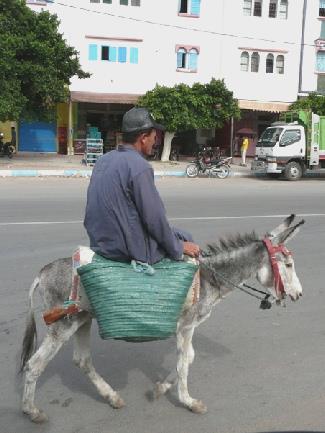
A man on a donkey passes us at Tamaner
We came to the beach at Sidi Kaouki and pulled into a beach car park. We ate lunch before going down with our Danish seats on to the huge sandy beach. There were sunbeds and palapas, and all kinds of beach rides - camels, horses, quad bikes - none of which had many takers. One or two experts were tearing along the beach on bare backed horses. This whole area is known as a place to surf. The waves weren't big, but too much for me. Adrian managed a short swim, but I had to suffice with getting splashed on the edge!
There was a campsite just a short way back from us, so having had enough sun, we made our way there. The entrance buildings were nicely painted in blue and white, the loo block had bougainvillea and geraniums outside, along with Norfolk Pines. The whole place was well looked after - a bit different from other places! There was nobody about, so we settled into a shady spot.
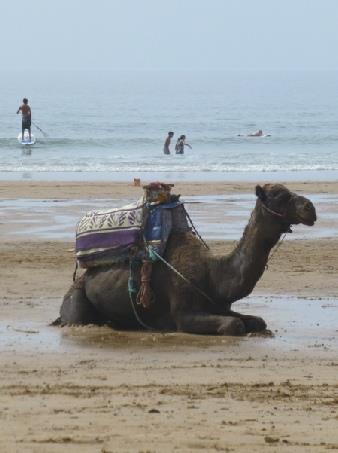
No-one for a camel ride, Sidi Kaouki
When it was dark, a man came for us to 'register'. Of course he had no change, so said he'd come in the morning.
Adrian cooked some of the sole he'd bought, outside. We ate out, coming in at 9 o'clock. The only 'wildlife' we'd seen was one cat. We left out our plate of fish trimmings – the plate was clean in the morning! The temperature was still warm at bedtime.
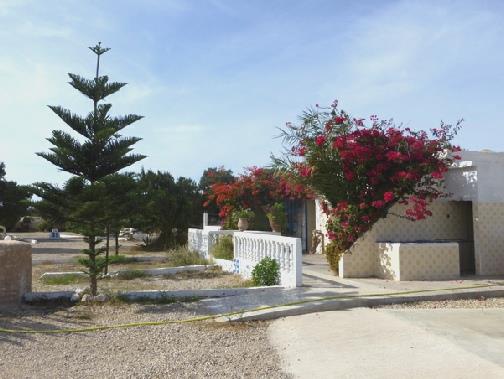
The well tended campsite at Sidi Kaouki
Monday 5th October Essaouira 75 miles
The night had been warm. At one time it became really windy so we had to shut the roof vents. It was a nice temperature when we sat out for breakfast. The man hadn't come by the time we left at 9.30 (we said that we'd be leaving at 9.00) so we left what change we had to pay for the campsite.
We drove back past the beach, which was deserted now, we just passed 2 donkeys. Back on the N1 we saw wild camels.
We reached the town of Essaouira and found a car park right by the town walls. We were ushered in, and paid our 40dh. Then a chap came along and asked if we wanted the van cleaned. I had said that this would be a good idea, so we handed over 100dh. The man didn't have a ladder - just an old chair with no bottom to it! He made a reasonable, but certainly not perfect, job!
Essaouira is certainly a different Moroccan town, and quite lovely. It is said to be everybody's favourite town, and hosts artists, writers and surfers as well as 'normal' tourists. With a French and Portuguese history, it has ramparts with lines of cannons, looking out over the rocky coast. It's what other Moroccan towns aren't – clean, smart and looked after.
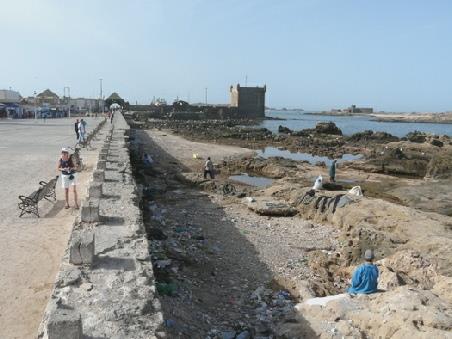
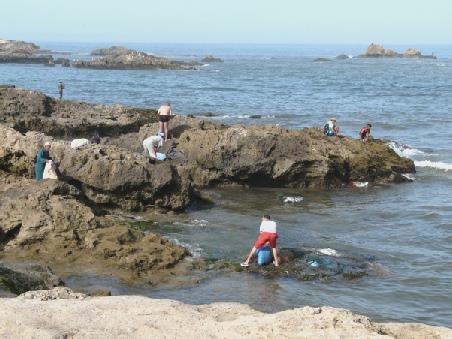
Men were diving for shellfish
Looking towards the bastion ‘Skala du port’ at Essaouira



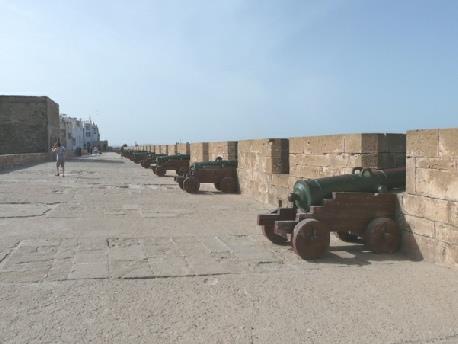
Various aspects of delightful Essaouira
We climbed the ramparts at Skala de la Ville, passing all the little woodworking stalls, and buying a nice inlaid box. We walked on through some of the narrow alleys, lined with stalls of all kinds, but much more 'serene' than we've been seeing. We stopped at a little cafe, and needing to be out of the strong sun, were placed on a table where a local man Ben was sitting with an English couple, talking about taking them on a visit. The couple soon left, and as we drank our coffee/Earl Grey, we chatted to Ben. He spoke good English, and was very sensible and far seeing. He had visited England, marketing Moroccan goods at Christmas markets. Of course he'd found it very cold! He said that he thought that the next generation of Moroccans would change, mostly because of internet, and they could see what the rest of the world was like. We really enjoyed our conversation with him.
We left to go in search for some babouches (Moroccan slippers) which we'd promised to get for Millie.
We made our way back to the van to have lunch, buying some bread on the way. We were parked right beside a row of fish stalls, and when we looked at them later, realised that we should have eaten there – the fresh fish looked really good.
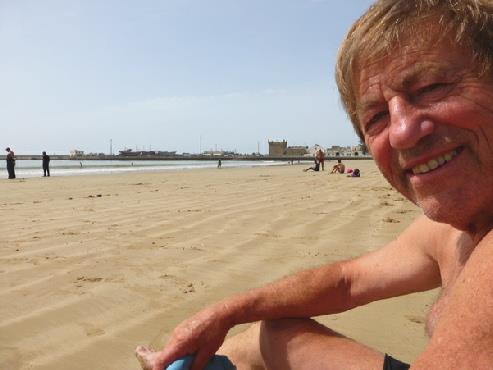
Moroccan forest
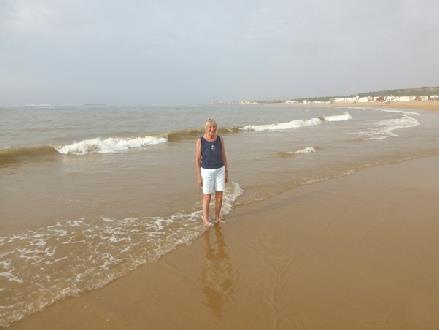
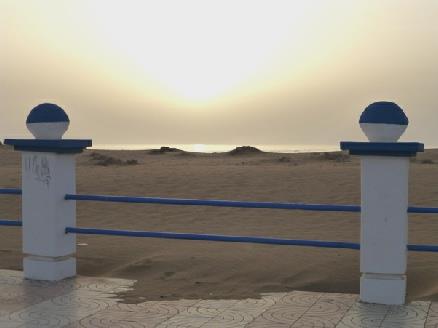
The beach at Souiria
Tuesday 6th October Oualidia - magical Morocco 68 miles
The 'call to prayer' this morning sounded like a load of bees buzzing!
There were hundreds of gulls on the beach, and the sun shone mistily.
It was just gone 8.30 when we drove back past the long, deserted prom, stopping to photograph some green fishing boats.
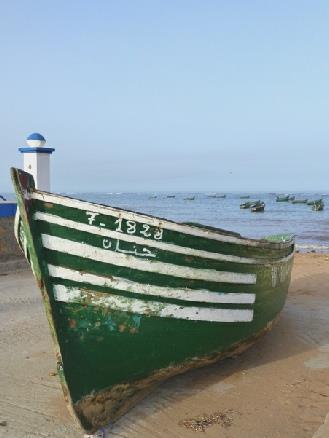
One of the many green fishing boats, Souiria
To the north of the Medina is 'Pottery hill', with kilns making the pottery that the town is famous for. There were masses of stalls selling pots and ceramics, which the owners were piling onto the ground, dusting them with a feather duster. The town had a very different feeling from Essaouira – there were virtually no tourists here.

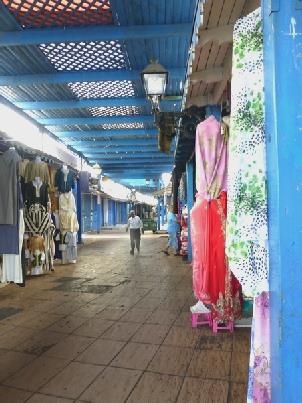
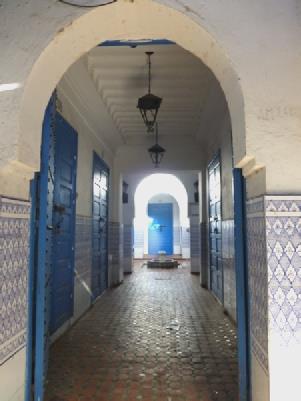

A few of Safi’s atmospheric little streets
We found our way to the 'Portuguese cathedral', which had never been finished, and is hidden by the mosque.

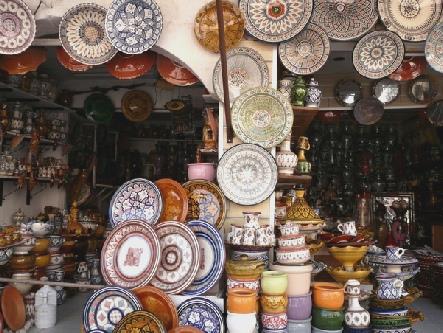
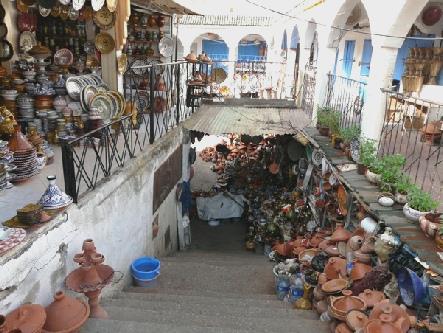
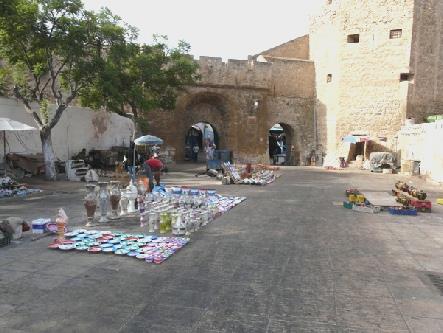
Pottery from Pottery Hill, Safi


We left here at 2.30, continuing northwards. We noticed today that people were happy to just wave to us. We continued through the arid landscape, where strips of land were planted out – tomatoes protected by brushwood fences. Further on, the cliff was inland, with the strips of cultivation running right down to the sea.
We reached the town of Oualidia, where we were hoping to stay. The roundabout had pretty pink and white bizzie lizzies growing in it. We drove around looking for a spot to park for the night. The campsite which had been here had closed down, but campers were able to park. We settled on a large bricked area beside a 'square', where there was just one other camper. Very soon a man called Ali came along. Giving us his card, he spoke (in English), saying that his wife cooked food - cous cous and tagine, which he would bring to the van, or we could go with him to eat fish on the beach. We opted for the latter, saying for him to collect us at 6 o'clock. The 'guardian' then came along, asking for 25dh, then another man came with 2 large fish - Adrian bought one, for 50dh, which the man gutted for us (and we then had to put in the freezer!) Later 2 more men came, one with fish, and one with lobster!
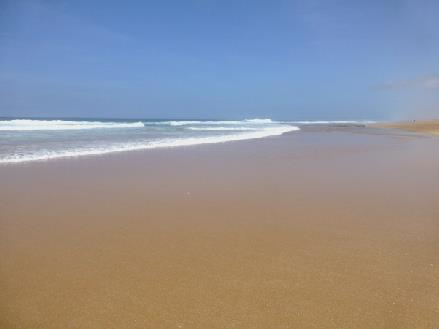
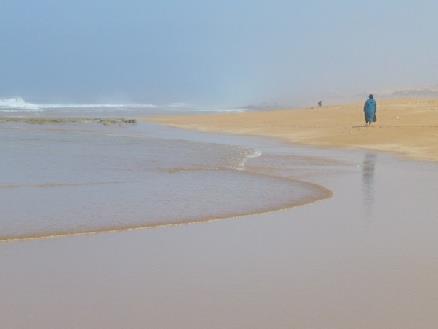
The beach at Cap Bedduza
We now walked across to the lovely beach – fine sand, but enclosed, a bit like Lulworth without the cliffs, with a sand island in the middle, and a lagoon of absolutely calm water. We both had a swim. It was so low key, reminding us of Mexico. There were a few canoes, pedalos and small boats giving trips, and just a few people – delightful!
We came back to the van, and at 6 o'clock, sure enough, there was Ali. We walked with him (and his moped) through part of the town and along to another wonderful beach where rows of green fishing boats were lined up. He led us to a table where he showed us all the seafood he could cook for us. We chose sardines, razor fish, calamari and mussels, and also oysters (which they didn't cook), declining the good looking fish.

Oualidia’s lovely lagoon
We sat at a table on the sand, overlooking the wonderful beach where the sea crashed onto rocks. We had taken our own beer, and sat in this idyll, watching the sun go down. The food was brought to us as they cooked it, along with bread and tomatoes, and we just soaked up the atmosphere to keep as a treasured memory.

Ali and his helpers about to cook our meal
The sun went into cloud again just before setting, but with the waves crashing up, it was so atmospheric.
The whole meal cost us 250dh (£16.50). We wished Ali luck – he seemed a really nice guy with a lot of go.
We walked back to the van, going beside the sea until we could go no further. A special place.


What a setting for supper!
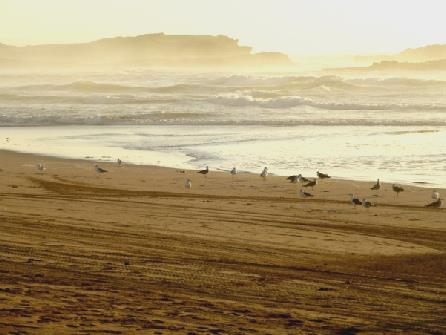
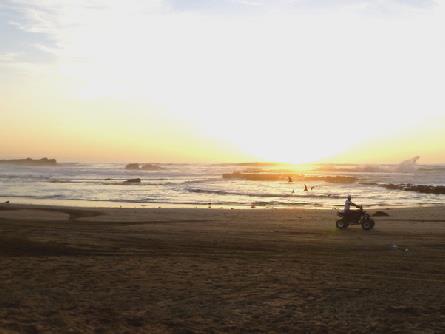
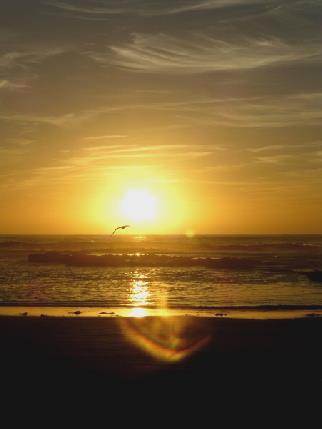
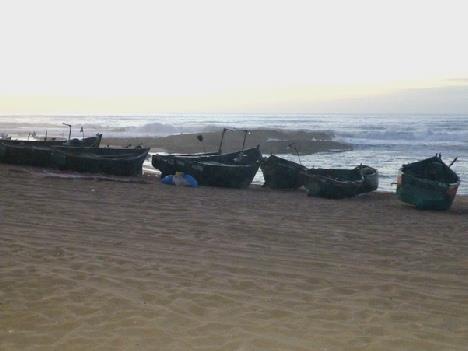
The end of a perfect evening

Wednesday 7th October Still enjoying the Moroccan coast 55miles
There was sea mist, which made it seem like a 'September Morn'! A collection of assorted dogs came into the square, making us think of '101 dalmatians'. They were all quiet, and seemed like a group of men meeting up!
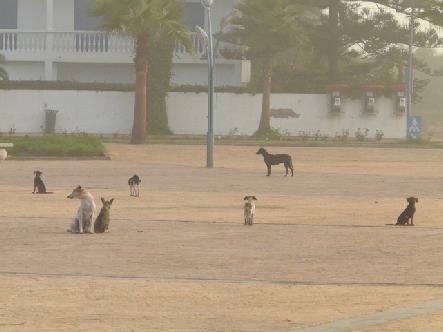
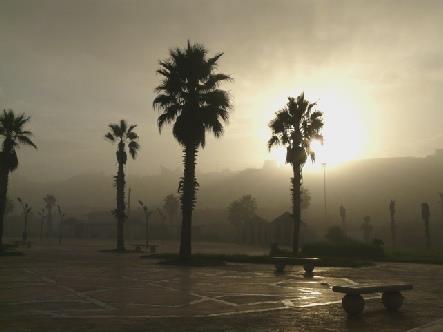
The dogs gather on a misty morning
After breakfast, we walked around this lovely town to have another look at the fishing boats on the beach where we ate last night. It all looked so different with the mist. The waves were far more violent today.
We had walked first along a difficult bit of shore which didn't really join up. The lagoon wasn't inviting today – the sand island had disappeared, and it was not calm like yesterday, so there was no enticement to swim! Two local ladies sitting on the beach said 'welcome' to us. Their 3 tiny children ran in and out of the sea, not bothered by the misty weather.
As we got back to the van, we were accosted by two different men on mopeds. One had oysters and the other calamari (and other seafood). Although we still had fresh fish, we were tempted, and bought both oysters and calamari, which the man prepared for us. Each cost 50dh. We were pleased to get the oysters, as they are farmed in the lagoon here – we saw the beds as we drove north. When a third man came with fish, we had to say no!
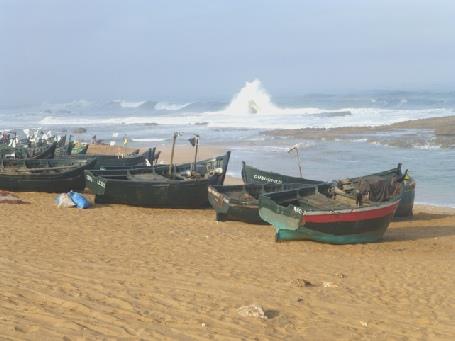

The waves and the fishing boats, Oualidia
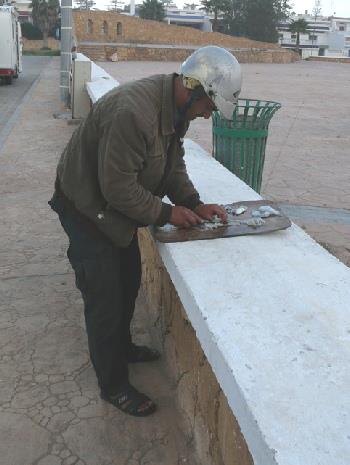
The man prepares our calamari
We passed a lot of stalls selling pumpkins, and stopped at one. We bought a small squash, and all sorts of other veg – 2 tomatoes, 2 small cucumbers, 2 egg plant, 2 eggs – the man kept suggesting more and more things. It all came to 15dh (£1). As we walked back to the van, the man came after us and gave us 2 vegetables that we found out later were called chayote! It was a nice stop.
The road was straight, between the cultivated strips, so there was nowhere to pull off. We finally found an odd bit of ground by some derelict buildings. We were beside another stretch of lagoon. This made a lovely place to sit and have our elevenses. We took our bum mats and sat on the honeycombed rocks, looking down to the blue, white and green pastoral image. It was like an impressionist painting. With our binoculars we could see a few sheep and cows on watery islands below. As the tide came in, they had very little land left to stand on! There were egrets, herons, cormorants and gulls. Tiny boats were making their way along the lagoon. A shepherd with his sheep sat nearby. The only bad thing was the broken glass on the ground.
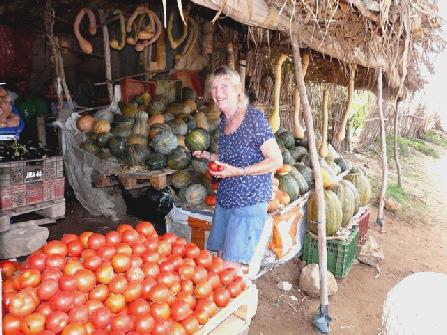
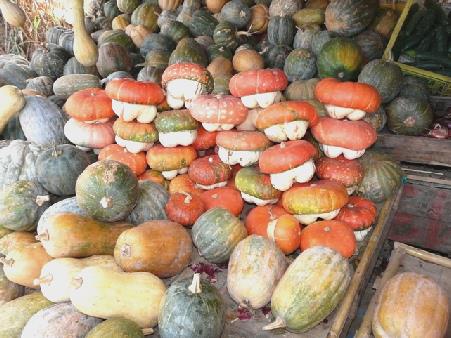


Buying from a roadside vegetable stall
It was 10 o'clock when we got going. We drove through a very productive area. There were strips of cultivated land either side of the road, and on the far side of the lagoon, which stretched for miles. People were busy tending their crops, in contrast to the many people we see just sitting or squatting.
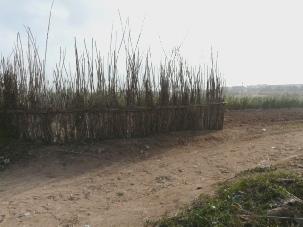


Driving through cultivated country
Before we reached El Jadida, we drove through a large industrial area. We pulled in beside a rough bit of beach, where sea poppies managed to survive amongst the litter. There was no lagoon here, so the waves came right in. We watched egrets and plovers on the beach as we ate lunch.
We then drove round the outskirts of El Jadida, not wanting to risk getting caught in narrow streets. It wasn't an easy drive for Adrian, with the erratic drivers and the frequent raised manhole covers (which made a change from all the manhole covers 3 inches below the road level, where they had resurfaced the road and not raised the covers). We reached a parking area, by the town walls. As we set off, we got talking to a young Polish girl, Magdalena. She was travelling alone, and obviously loved travelling. A nice girl and we enjoyed our chat!

Impressionist lagoon
The old Medina of this town is known as Cite Portugaise. It is in fact very small, but the roads in it are wider, which meant that cars pushed their way through as well as mopeds. The 'Citern Portugaise', the underground cistern which was supposed to be amazingly tranquil, was unfortunately closed when we walked past (siesta time). We made our way up on to the ramparts, which were great fun – we walked quite a way round, but after a bit, the path had been sadly neglected. Adrian was just bemoaning this fact, when we came to some workers trying to tidy it up by removing weeds. We could see parts of former churches, but generally felt that there wasn't much to see. We walked across to some local stalls, but by then had had enough of walking around in the heat!
We made our way through the bad mannered traffic to Carrefour, where we bought a few more things, aware that our time in Morocco is coming to an end. We then drove to Camping International, which despite uncomplimentary comments in our book, suited our needs OK. The first thing we did was to fill the water tank.
We ate the oysters and the calamari for supper – once Adrian had managed to open the oyster shells! It all tasted good.
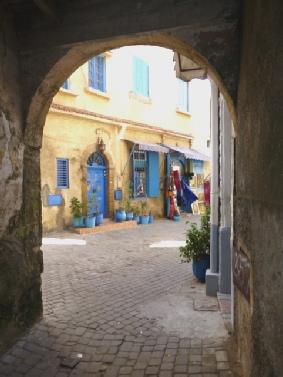
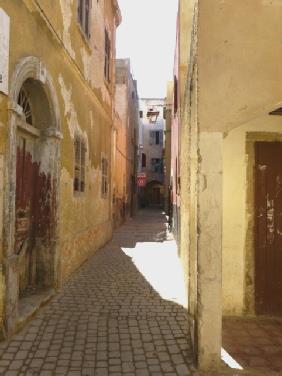
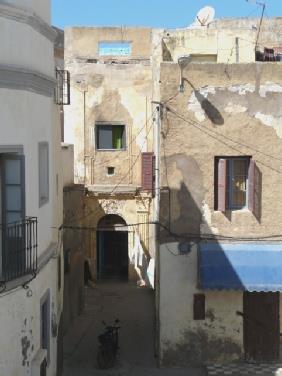
El Jadida
Thursday 8th October A very Moroccan town 49 miles
This morning we had a group of peacocks in the campsite for a change! We sat outside in the coolish sunshine for breakfast.
As we went to leave, just after 10 o'clock, dozens of workers were at the little shop at the entrance, getting their morning drink.
We drove on by the sea, noticing the well kept flower beds beside the road, which was planted with Norfolk pines. There were tall trees , and dozens of Moroccan flags. The lack of litter was noticeable. We saw notices advertising 'salon de cheval', from 13th-18th October, so maybe that's why it was all so smart.
We reached the town of Azemmour, driving right around the walls until we came to the river. There were no people about here at all. We parked and walked into the walled town, which although our book said was quite small, had plenty of streets to wander around in. We saw no tourists at all. It was very much a working Moroccan town, with people busy in the little streets working with wood and with cement.
Very many of the 'garage door' shops were selling bread. Little children, some on their way back from kindergarten, said 'bonjour'. Many of the walls had murals or graffiti painted on them, but they hadn't worn well.
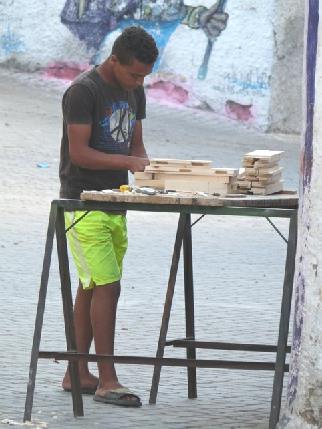
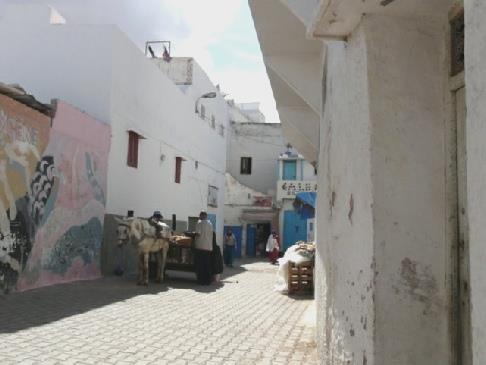
Busy in the street, Azemmour
Once more the blue and white colouring dated from the time of Portuguese occupancy. We managed to find our way back to the van, where a little old lady was sitting, saying that she'd guarded it for us! We gave her a few coins, then she smilingly asked for food and cigarettes! She waved as we left.
Outside the walls, the town was teeming with Moroccans by the shops and stalls. Young children were returning from school. We drove across the river, and looked back to the town before driving on along straight roads lined with trees, and with 'netted greenhouses'. Children waved as we passed.
Looking out for somewhere to stop for lunch, we turned down to a road lined with trees, which ended right by a remote sandy beach plage Sidi Bounaime.
After lunch we walked down to the edge of the sea, which was much further than we'd thought. For as far as we could see in both directions, it was just empty beach. It made us think of Quiberon.
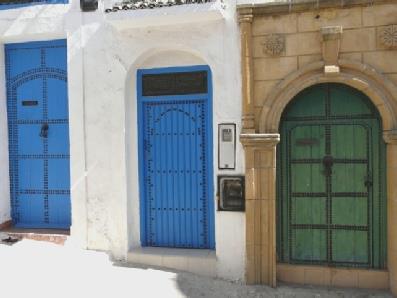
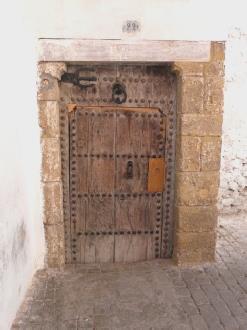

Azemmour had many wonderful doors
It was 2.15 when we drove back through the forest of eucalypts to the road. The road surface now was not good. We were amused when a taxi passed us with a man sitting happily in the boot! We passed donkeys in the fields, scratching for food. We saw a lot of unfinished development, and then soon after 3 o'clock we reached the campsite at Dar Bouazza.
I made a 'vegetable tagine' for supper, including some of the chayote. It was pleasant enough to sit outside. We worked more on the website
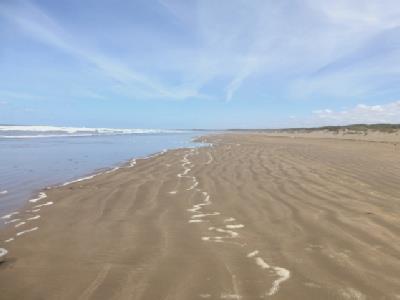

Just empty beach in both directions, Sidi Bounaime
Friday 9th October Play it again! 42 miles
Okay, we know that the film of Casablanca was all made in the studio at Hollywood, and that the line 'Play it again Sam' doesn't appear in the film, but we thought that we ought to get at least a glimpse of the town!
For the first time, the night had felt really cool. By 9 o'clock we were on our way. Our books had advised against driving into Casablanca, saying that the traffic was bad, and the roads often gridlocked. We went for it, and although it was busy – with cars rather than mopeds and carts – Adrian managed expertly.
We had no real idea where to park, but as we neared the centre we saw a parking area and were ushered in. A chap came up immediately and offered to take us into the Medina. We thanked him and said no. Later, as we walked into the Medina, there he was again, but he only gently hassled us!
The part we had wanted to see was the 'art deco' area, and we weren't far from that. We left at 10 o'clock and tried to follow a walking tour in Lonely Planet. We never do very well with these (as not many of the roads are named), and this was no exception! The thing was, there was nothing really to see! Art deco doesn't impress us, so we just had to enjoy the fact that we were actually in Casablanca!
We had read that it was a very western town, and certainly it could have been many a place in Europe. We saw couples walking about together, which isn't usual in Morocco, but we still saw several women covered all in black, and the many cafes nearly all had men only in them. Adrian enjoyed seeing the modern trams, but not being city people we didn't linger long.
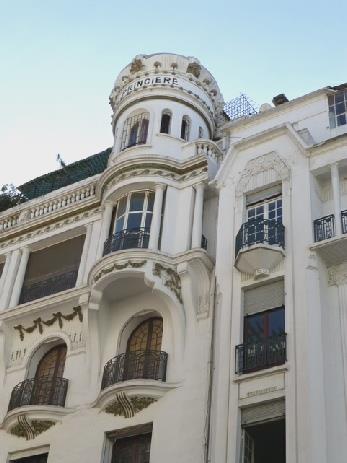
A nice bit of art deco, Casablanca
We made our way over to the Medina – a subway had been built, but was blocked off and not in use! The area of the Medina we were in sold clothes and shoes, for Moroccans, but we found a little bakers to buy a loaf and a cake. Following our noses, we managed without too much trouble to find our way out again – right opposite where we had parked.
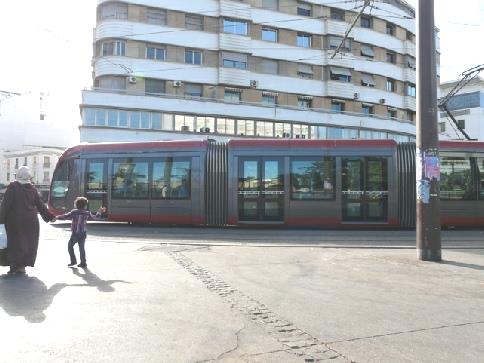
Adrian liked seeing the trams (and so did Fred)
It was very warm now as we left late morning, making our way past Rick's cafe – a mock up of the one in the film. We parked beside the road while Adrian went across to at least say that he had seen it!

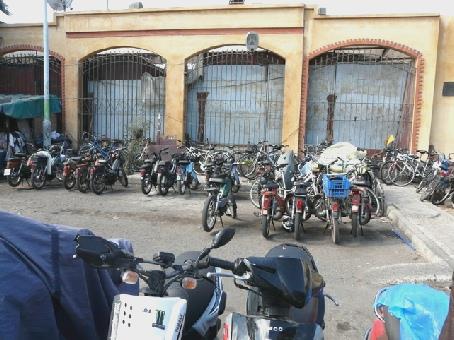
Anyone want a moped?
Are they selling ladders or are they window cleaners?
Now it was time to head out of Casablanca – we were pleased that it had been relatively trouble free, despite our misgivings about driving there.
Of course we could find nowhere to stop for lunch – once out of the city there was a line of houses all along by the coast.
We reached Mohammedia (renamed from Fedala after Mohammed V died in 1961). After driving past the port and industrial area, there was a vast amount of development taking place - smart apartment blocks, and not appealing to us. We resorted to parking in a shady side street to have our lunch.
Now we headed for nearby l'Ocean Bleu campsite at El Mansouria. The last part was a rough track beside the sea. We found the pleasant site, right by the sea, and with a wall around it. Just one other camper was there. Men were trimming the eucalyptus trees which sheltered each pitch, so we were asked to park in the rear part of the site. The site was being encroached on from all sides by building development. We took some washing up to the machine, then walked out to the lovely beach, hoping that the site will be able to remain here in the future.
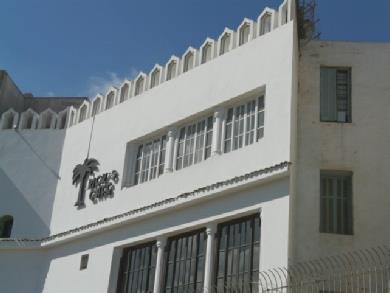

Rick’s cafe - where’s Humphrey?
Unfortunately the washing cycle was long, and by then the sun was low, so the washing didn’t dry.
While we were cooking some of our supply of fish, a man came by trying to sell us more!
We finished this part of the website.

The nice beach at El Mansouria
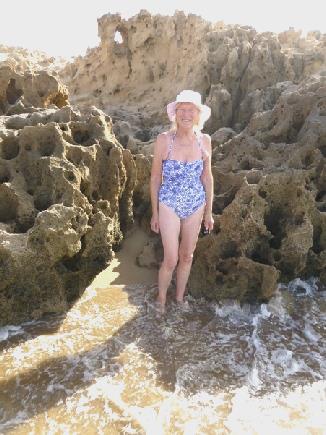
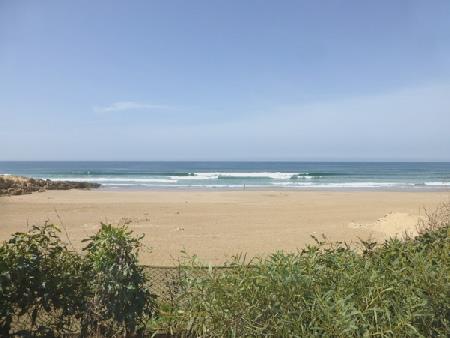
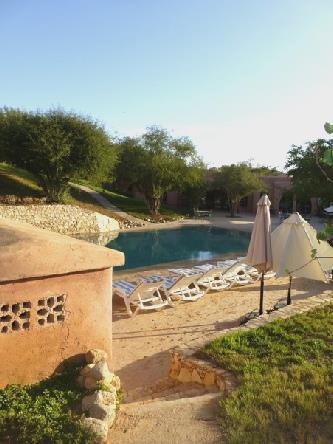
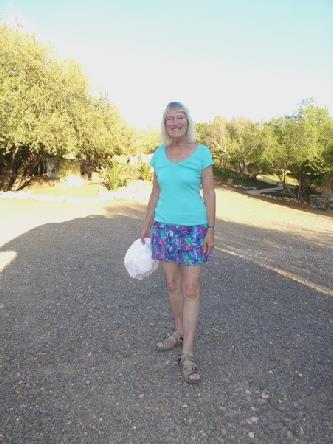
We needed somewhere to stop for lunch, and a 'Marjanes' car park seemed to fit the bill. After lunch, we went into the store and bought drinking water, bread, and a fresh pizza for tonight. As expected, the fruit & veg was worse than usual after the holiday.
It was 2 o'clock when we left here, and about half an hour later we reached the motorway and set off towards Agadir.
We drove through flat land at first before coming into the red coloured High Atlas. The road was good, so we were able to continue listening to 'Supertramp'. Before Agadir we made a long, long descent. We left the motorway at 4.20. It had cost us £10 and had been a good journey.
A quarter of an hour later we arrived at Paradis Nomade, our campsite for tonight. Once more we were the only campers, but there was a group of French people presumably from the hotel. There was once more a lovely swimming pool, so we soon made our way there. Swallows swooped down over the water, and red damselflies.
It was 2 o'clock when we left here, and about half an hour later we reached the motorway and set off towards Agadir.
We drove through flat land at first before coming into the red coloured High Atlas. The road was good, so we were able to continue listening to 'Supertramp'. Before Agadir we made a long, long descent. We left the motorway at 4.20. It had cost us £10 and had been a good journey.
A quarter of an hour later we arrived at Paradis Nomade, our campsite for tonight. Once more we were the only campers, but there was a group of French people presumably from the hotel. There was once more a lovely swimming pool, so we soon made our way there. Swallows swooped down over the water, and red damselflies.
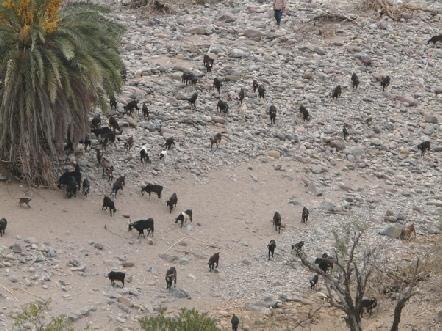

We took the R105 road, which was, as our guide book says, rather dull at first. There were sandy tracks off, but nowhere to pull off. We at last stopped in the town of Imi Mquourn to have coffee, and we phoned Emma. It was nice not to be hassled at all. What we noticed today is that people we passed happily waved to us. As we continued, I was pleased to see a whole lot of goats up a tree, as I'd seen pictures of. Adrian saw a ground squirrel which we read are in this area.
We were now ascending into the Anti Atlas mountains. We went over a small pass before coming to the town of Ait Baha with its neat pavements and mini palm trees. We saw hundreds of goats in the valley below.
We were now ascending into the Anti Atlas mountains. We went over a small pass before coming to the town of Ait Baha with its neat pavements and mini palm trees. We saw hundreds of goats in the valley below.
Today was different in that it was mostly cloudy, and cooler than of late (reaching upper 20's°C)
While we ate our breakfast outside we watched blackbirds, but not all had yellow beaks. We left this nice (but more expensive than others) site at 9.45, taking a rural route towards Agadir. We saw a lot of wild donkeys beside the road.
We skirted Agadir, having to drive through the suburbs, which were as drear as always. Adrian found the road markings difficult, and couldn't cope with the road having been dug up and not reinstated. There was a plethora of battered blue and white taxis, also many horses and carts.
While we ate our breakfast outside we watched blackbirds, but not all had yellow beaks. We left this nice (but more expensive than others) site at 9.45, taking a rural route towards Agadir. We saw a lot of wild donkeys beside the road.
We skirted Agadir, having to drive through the suburbs, which were as drear as always. Adrian found the road markings difficult, and couldn't cope with the road having been dug up and not reinstated. There was a plethora of battered blue and white taxis, also many horses and carts.
Red granite scenery near Tafraout

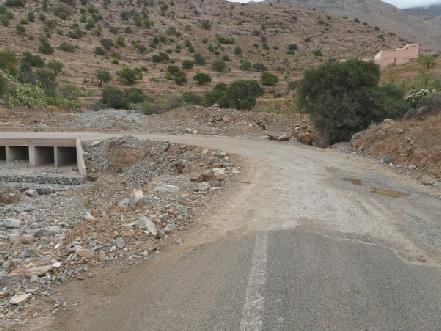
Again people today were keen to wave to us. When we stopped for coffee at the top of Col du Kerdous, we had sun, wind and rain! We were pleased to see a crested lark. There was a mast some way above us. A security man waved as he walked past to make his way up there, then returned and asked us if we'd like to go up to enjoy the view! We thanked him, but it was too far for me to walk, and too rough to drive the van.
We viewed the different options to drive from here to the Atlantic coast. Adrian boldly opted for a rural route which meant driving back a couple of miles first. The tarmac on the road we took was really narrow again, but in true Murray Walker style, Adrian said, 'but I don't expect there'll be much traffic'. Well, there was, so it was another nerve racking journey for me! We thought that after the road junction, things might improve, but they were just the same! A group of young children, miles from anywhere, waved to us, then we passed what must have been the school, and a whole lot of children ran out and waved! We were driving through red, barren scenery, and we crossed many bridges which had had trouble with floods.
We viewed the different options to drive from here to the Atlantic coast. Adrian boldly opted for a rural route which meant driving back a couple of miles first. The tarmac on the road we took was really narrow again, but in true Murray Walker style, Adrian said, 'but I don't expect there'll be much traffic'. Well, there was, so it was another nerve racking journey for me! We thought that after the road junction, things might improve, but they were just the same! A group of young children, miles from anywhere, waved to us, then we passed what must have been the school, and a whole lot of children ran out and waved! We were driving through red, barren scenery, and we crossed many bridges which had had trouble with floods.
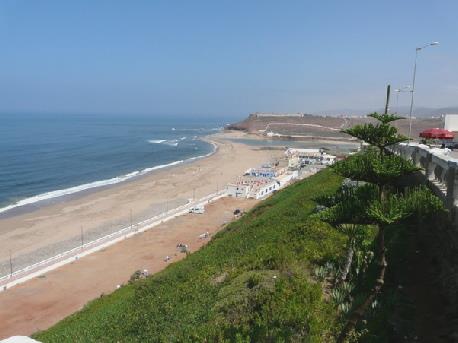

There were some nice buildings around it, but we were more interested in finding some lunch! It seemed that there were several cafes here, but all of the ones we saw had only men in them – drinking tea and not eating! We didn't even find a shop to buy food. We came across the Municipal Market, which was just closing up, but didn't ever locate the fish and vegetable markets which are held daily.
We made our way to the promenade above the beach and at the eleventh hour came to Cafe Tagout. We looked at the blackboard menu, and decided to eat here, although there were still no women sitting at the tables. (I thought that there was one, but it was a man with a head dress!) Later two couples did stop for a drink. I ordered fish soup, which was very good. Adrian had fish tajine – I thought that the fish looked just like ours which we had the other day! We waited an absolute age for the food, so at least it was fresh. Adrian asked for a large bottle of water, as we had seen on other tables, but the waiter said 'only small' (perhaps they had just sold out). As my meal came with some bread, we had a bit extra to take back with us for later.
It was a delightful setting to sit with the blue sky merging into the blue sea. This seems to be a surfers place. We saw several young Europeans go by, women in short shorts and skimpy tops.
We walked back down the many steps to our lovely position by the sea.
We made our way to the promenade above the beach and at the eleventh hour came to Cafe Tagout. We looked at the blackboard menu, and decided to eat here, although there were still no women sitting at the tables. (I thought that there was one, but it was a man with a head dress!) Later two couples did stop for a drink. I ordered fish soup, which was very good. Adrian had fish tajine – I thought that the fish looked just like ours which we had the other day! We waited an absolute age for the food, so at least it was fresh. Adrian asked for a large bottle of water, as we had seen on other tables, but the waiter said 'only small' (perhaps they had just sold out). As my meal came with some bread, we had a bit extra to take back with us for later.
It was a delightful setting to sit with the blue sky merging into the blue sea. This seems to be a surfers place. We saw several young Europeans go by, women in short shorts and skimpy tops.
We walked back down the many steps to our lovely position by the sea.
The 'call to prayer' sounded like a herd of unharmonious cows this morning! The birds were infinitely more tuneful! Adrian fixed the netting on the upper bed so we had no more disasters like yesterday!
Breakfast was pleasant in the sun, except for the flies!
We walked into Tiznit, but this wasn't a great success! I wasn't feeling too good – maybe as the result of eating a few dates yesterday. We had bought a large box of fresh dates in Ouarzazate, planning to take them back to England, but they appeared to be fermenting!
Once more, we couldn't make our map tie up with the roads. A few stalls were opening up, and although we needed fruit and vegetables, they didn't look in a good condition.
Breakfast was pleasant in the sun, except for the flies!
We walked into Tiznit, but this wasn't a great success! I wasn't feeling too good – maybe as the result of eating a few dates yesterday. We had bought a large box of fresh dates in Ouarzazate, planning to take them back to England, but they appeared to be fermenting!
Once more, we couldn't make our map tie up with the roads. A few stalls were opening up, and although we needed fruit and vegetables, they didn't look in a good condition.
While we were looking at the map, a man came up to us, trying to tell us about his silver shop. He did tell us though that the souks didn't open until 10.30, and this was about 9.45. I found the town rather dowdy and in need of a bit of TLC. The ladies in this area are dressed differently, wearing what looks like a sari, but covering head and face.
We made our way back to the site and Adrian went to pay. He was amazed both last night and this morning at the bureaucracy and form filling – he was gone ages. It appeared that the cashier wasn't there, and the man needed the right money. We counted up all our change, and had just enough, but of course that left us with no small change.
We left at 10.15, driving through the smartly paved outer streets lined with neatly pruned trees, in contrast to the inner town. We stopped for diesel at a garage which took Visa.
We joined the N1 north, which was mostly OK, except for the parts round roadworks, which had dreaded unmarked topes.
We turned off at Had Belfa, following a wandering route and crossing the Massa River near where it comes out to the sea. After our experiences with the flash floods, we weren't very sure about it! Eventually we reached vast unshaded Sidi Wassay campsite right by the sea. There were 120 empty pitches! We were ushered in, and the man pointed out a lower level, which was right above the beach.
As we saw that they had washing machines here (several in fact, for the 'season'), and I'd wanted to wash our large towels, we put in some washing, pulling in nearby to have our lunch. Loaded with the clean things, we drove down to the lower level and hung it out. Adrian tried the electric, but after getting a shock from it, decided against using it!
Later in the afternoon, we walked out onto the vast sandy beach, paddling in the waves (which were high) before walking along to the honeycombed rocks at the end.
We made our way back to the site and Adrian went to pay. He was amazed both last night and this morning at the bureaucracy and form filling – he was gone ages. It appeared that the cashier wasn't there, and the man needed the right money. We counted up all our change, and had just enough, but of course that left us with no small change.
We left at 10.15, driving through the smartly paved outer streets lined with neatly pruned trees, in contrast to the inner town. We stopped for diesel at a garage which took Visa.
We joined the N1 north, which was mostly OK, except for the parts round roadworks, which had dreaded unmarked topes.
We turned off at Had Belfa, following a wandering route and crossing the Massa River near where it comes out to the sea. After our experiences with the flash floods, we weren't very sure about it! Eventually we reached vast unshaded Sidi Wassay campsite right by the sea. There were 120 empty pitches! We were ushered in, and the man pointed out a lower level, which was right above the beach.
As we saw that they had washing machines here (several in fact, for the 'season'), and I'd wanted to wash our large towels, we put in some washing, pulling in nearby to have our lunch. Loaded with the clean things, we drove down to the lower level and hung it out. Adrian tried the electric, but after getting a shock from it, decided against using it!
Later in the afternoon, we walked out onto the vast sandy beach, paddling in the waves (which were high) before walking along to the honeycombed rocks at the end.
The route took us down to the beachfront, with all its eating areas, then back through the town, past some gardens I'd wanted to see, but were rather uninspiring, and was about to go down again. We stopped at a red traffic light, and Adrian thought it good to get off there, which we did. Now we wanted to find our way to Carrefour (Adrian's plan), hoping that they had a 'cave' to replenish our beer and wine supplies.
With the aid of Adrian's 'tablet' we got to Carrefour (yes, we could have parked the van there, but weren't to know). We found our way down to the 'cave', stocked up again, then had a quick look around upstairs, buying some mushrooms, chicory and ham. The plan was to get a taxi back to the campsite. We walked outside – along came a taxi, and for 80p, including tip, we were whisked back right to our door! A successful day!
It was now 4.30, so we enjoyed a cup of tea and custard slice.
Later we enjoyed sitting out for the meal of fish (loup – 'wolf'!) which Adrian had cooked outside, joined by some of the dozens of cats here, including the tiny kitten I'd seen earlier.
With the aid of Adrian's 'tablet' we got to Carrefour (yes, we could have parked the van there, but weren't to know). We found our way down to the 'cave', stocked up again, then had a quick look around upstairs, buying some mushrooms, chicory and ham. The plan was to get a taxi back to the campsite. We walked outside – along came a taxi, and for 80p, including tip, we were whisked back right to our door! A successful day!
It was now 4.30, so we enjoyed a cup of tea and custard slice.
Later we enjoyed sitting out for the meal of fish (loup – 'wolf'!) which Adrian had cooked outside, joined by some of the dozens of cats here, including the tiny kitten I'd seen earlier.
Gutted !
I had seen the large swimming pool, which was empty and derelict.
As we left at 9.45, the 'guardian', who we'd paid earlier, wanted to see the scrappy receipt. He then scrutinised it, took it into a building and finally said 'OK'!
We first drove down to the beach, parking by the 'big wheel', where we remember Tracy & Colin saying you could park. The first car park attendant didn't want to know our van, but the adjoining one ushered us in. The car parks were already busy. We walked onto the vast, sandy beach, where a lot of people were enjoying themselves. Agadir had a nice , spacious feel with no high rise buildings and a lot of green parkland.
We walked right across to the sea and paddled, before having a short sit on the sand. Very loud music suddenly blared out, seemingly from a stage we'd seen yesterday when on the petit train, presumably tuning up for a 'Tolerance concert' tomorrow. As we walked back to the van, 2 men did acrobats along in front of the cafe
As we left at 9.45, the 'guardian', who we'd paid earlier, wanted to see the scrappy receipt. He then scrutinised it, took it into a building and finally said 'OK'!
We first drove down to the beach, parking by the 'big wheel', where we remember Tracy & Colin saying you could park. The first car park attendant didn't want to know our van, but the adjoining one ushered us in. The car parks were already busy. We walked onto the vast, sandy beach, where a lot of people were enjoying themselves. Agadir had a nice , spacious feel with no high rise buildings and a lot of green parkland.
We walked right across to the sea and paddled, before having a short sit on the sand. Very loud music suddenly blared out, seemingly from a stage we'd seen yesterday when on the petit train, presumably tuning up for a 'Tolerance concert' tomorrow. As we walked back to the van, 2 men did acrobats along in front of the cafe
The super wide sandy beach at Essaouira
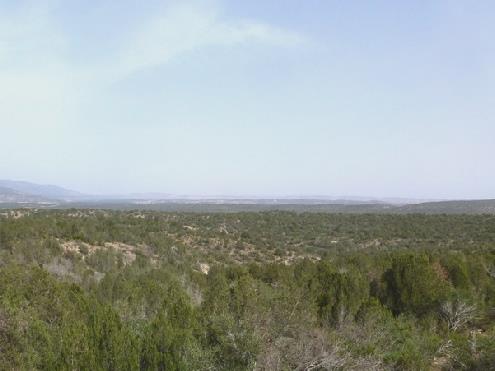
Afterwards we made our way towards the enormous sandy beach, but it was a long way before we could get to a gap in the wall to get down to it. Interestingly there were no sunbeds, horses, donkeys or amusements of any kind, just a scattering of people enjoying the beach and the sea.
We both had a very short swim, but we found the water cool and the waves unpredictable. We looked across to Mogador Island (the old name for Essaouira), a wildlife sanctuary for Eleonoras Falcons.
We walked back to the van, leaving lovely Essaouira at 3.00pm.
We took the R301 north, which runs nearer to the sea than the N1. It was mostly well surfaced with very little traffic, although we did come to a large broken down truck blocking the road.
We both had a very short swim, but we found the water cool and the waves unpredictable. We looked across to Mogador Island (the old name for Essaouira), a wildlife sanctuary for Eleonoras Falcons.
We walked back to the van, leaving lovely Essaouira at 3.00pm.
We took the R301 north, which runs nearer to the sea than the N1. It was mostly well surfaced with very little traffic, although we did come to a large broken down truck blocking the road.
We drove through a nonstop forest of short green trees, passing endless empty sandy beaches. We came to the shabby, scruffy little town of Dar-Caid-Hadji, in such contrast to Essaouira, seeing a lot of pony and traps.
At 4.40 we arrived at the seaside town of Souiria, where there was a place where motorhomes could stay – there is a lack of campsites just here. We parked right beside a beach of golden sand, along with three other motorhomes
We walked across the wide beach and came back to sit behind our white and blue railings with the very Moroccan town up behind us.
A chap came and knocked at the door in the dark. He asked for 30 dh for parking and gave us a receipt.
At 4.40 we arrived at the seaside town of Souiria, where there was a place where motorhomes could stay – there is a lack of campsites just here. We parked right beside a beach of golden sand, along with three other motorhomes
We walked across the wide beach and came back to sit behind our white and blue railings with the very Moroccan town up behind us.
A chap came and knocked at the door in the dark. He asked for 30 dh for parking and gave us a receipt.
We drove on to Safi through barren land above the sea, passing a lot of work where they were building a new port. Safi is Morocco's third busiest port, exporting phosphates, and south of the town is very industrial. There are also a lot of topes!
Safi (also called Asfi for the dyslexic) is a large town, which we drove through, stopping by the walls of the old town, where we could park.
By 9.45 we were on our way into the Medina – supposedly quite small, but once again, just a maze of little passages. Everything was predominantly blue and white, a legacy from its Portuguese history, and looked very attractive. Many of the stalls were not yet open, and some were just opening up.
Safi (also called Asfi for the dyslexic) is a large town, which we drove through, stopping by the walls of the old town, where we could park.
By 9.45 we were on our way into the Medina – supposedly quite small, but once again, just a maze of little passages. Everything was predominantly blue and white, a legacy from its Portuguese history, and looked very attractive. Many of the stalls were not yet open, and some were just opening up.
The ‘Portuguese cathedral’, Safi
It was strange to see trains running past the castle to the port (presumably exporting the phosphate) – the first ones we've seen in Morocco.
We had bought a tiny loaf, and ate some when we got back to the van.
We then drove out of Safi, taking a wrong turn by the port. In coming back to the roundabout, the policeman there stopped us and asked us where we were going. We made him understand 'north'. He then held up the traffic so that we could go!
Just north of the town, we pulled in to view the massive harbour below, and the beach of Sidi Bouzid beside it.
We now drove through arid, beige coloured, flat land, which ended at cliffs by the sea, making us think of the Nullabor.
At Cap Bedduza we drove down to a beach of fine golden sand, which was practically deserted. There was a long promenade, and buildings were in blue. We had lunch before walking across to paddle in the waves – it wasn't the place for swimming, having big waves. We walked along to some rocks, when a large wave wetted us more than we'd intended!
We had bought a tiny loaf, and ate some when we got back to the van.
We then drove out of Safi, taking a wrong turn by the port. In coming back to the roundabout, the policeman there stopped us and asked us where we were going. We made him understand 'north'. He then held up the traffic so that we could go!
Just north of the town, we pulled in to view the massive harbour below, and the beach of Sidi Bouzid beside it.
We now drove through arid, beige coloured, flat land, which ended at cliffs by the sea, making us think of the Nullabor.
At Cap Bedduza we drove down to a beach of fine golden sand, which was practically deserted. There was a long promenade, and buildings were in blue. We had lunch before walking across to paddle in the waves – it wasn't the place for swimming, having big waves. We walked along to some rocks, when a large wave wetted us more than we'd intended!
Marrakech to Casablanca, Morocco











